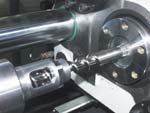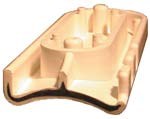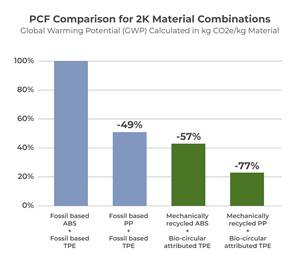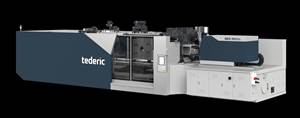Coinjection's New Look: Two Screws, One Barrel By Mikell Knights
Coinjection molding has always been viewed as a cost-saving technique that can put a lower cost material such as off-spec, recycled, unpigmented, or foamed resin into the core of a two-material sandwich. Coinjection also aids a molder looking to make value-added products such as soft-touch parts or ones with a cosmetic surface over a glass-reinforced core.
Coinjection molding has always been viewed as a cost-saving technique that can put a lower cost material such as off-spec, recycled, unpigmented, or foamed resin into the core of a two-material sandwich. Coinjection also aids a molder looking to make value-added products such as soft-touch parts or ones with a cosmetic surface over a glass-reinforced core.
So why isn't everybody doing it? There's a simple answer. The machinery costs too much and is more complex than using two standard molding machines, says Joel Thomson, plastics engineer at Community Products in Rifton, N.Y., a molder of educational products for children with disabilities. To overcome these obstacles, Thomson developed a new coinjection technology that is reportedly easier to use and maintain. Most important, it uses a standard molding machine, since his company wasn't ready to scrap their newly-purchased conventional fleet. Thomson's invention was put into commercial use this spring at Community Products, and a new division, Twinshot Technologies, has been formed to market the patent-pending process.
As Community Products discovered, coinjection doesn't have to be a high-end process reserved for the elite ranks of Big-Three auto makers. None of the molds used so far with the Twinshot process were designed specifically for coinjection. Twinshot Technologies is working with machine suppliers to develop a simple commercial retrofit package that will enable any conventional machine to be converted quickly and inexpensively into a cost-saving coinjection machine.
A molder's invention
What Thomson developed was a unit designed with a solid screw enclosed within a second, hollow screw. Each screw independently processes a different melt stream. The melt stream is pooled in a common section of the barrel in front of the screws, with one material accumulating first, then the second. Then the pool of layered melts is injected into the mold in one stroke.
Unlike previous coinjection machines, Twinshot has a single conventional barrel design. The process does not require extra heater bands and thermocouples, extra joints in the barrel (to mate the melt streams from separate injection units), or nozzle valves. It needs no extra hydraulic pumps (to start and stop each injection unit) and no accumulators, special computers, or extra external equipment, says Thomson. His technology also requires less floor space and uses less energy than a conventional coinjection system, he adds. It also may be applicable to smaller presses and smaller parts. Twinshot can be adapted to machines as small as 40 tons and to virtually any larger unit, according to Thomson.
Injection of both materials from one unit eliminates timing problems in coordinating two different injection units, and material injection is programmed in a single velocity profile. The response time of traditional nozzle valves can cause problems for small shots, high velocities, and short fill times. In addition, the long manifold design used in conventional coinjection setups may lead to significant losses of melt pressure, velocity, and shot-size control. With Twinshot, the manifold is eliminated, and the nozzle configuration is completely standard, says Thomson.
Cost savings
Material cost savings are probably the primary benefit of any coinjection technology, and Twinshot is no exception. Twinshot can typically replace 25-35% of a part's weight with lower cost material in the core. Savings are also possible by using conventional or microcellular foam cores with solid aesthetic skins.
One typical Twinshot application at Community Products is an ABS part with a high-gloss skin and a 30% glass-filled core. The extra cost of the reinforced core material was offset by eliminating color concentrate in the interior of the part. Thus, added strength and rigidity was delivered at the same cost as a single-layer, unreinforced part with color concentrate all the way through, says Thomson.
The firm predicts that Twinshot operating on a 400-ton machine and molding parts with a core of recycled material that constitutes 30% of the part can save a molder $42,000 a year using a commodity resin and $160,000/yr with a more costly engineering resin. The firm presents a "savings calculator" on its website at www.twinshot.com.
The low cost of the machine is what really makes Twinshot unique, Thomson claims. The firm says its coinjection technology, including license fees, will likely add 25% to the cost of a new machine. It can also be retrofitted to an existing machine at around 30% of the cost of a new machine. Prior to developing its Twinshot technology, Community Products purchased a conventional 300-ton coinjection system for $270,000. In comparison, a new 300-ton machine equipped with Twinshot would likely cost $200,000, says Marcus Mommsen, Community Products' chief financial officer. Mommsen says his firm intends to retrofit all eight standard injection machines at its Elka Park, N.Y., manufacturing plant and expects to spend a total of around $200,000. "One conventional coinjection machine costs more than that," Mommsen says.
The company seeks to license Twinshot technology through existing machine suppliers and qualified rebuilders. A one-time license fee based on barrel diameter will be included in the price of every new or retrofit machine. "The higher the injection capacity, the more the potential cost savings over a standard machine, and thus the higher license fee," says Thomson. The Twinshot license is all-inclusive for the life of the machine.
How the process works
At present, Community Products is the only active user of Twinshot technology. The technology is currently installed on just one 85-ton Milacron Vista press that is used to mold components for children's furniture.
Converting a standard machine required changes to four areas of the press: the screw, motor/clutch, barrel feed area, and check-valve.
A narrow, non-cooled feed port is added to allow secondary material to be fed to the inner screw. Twinshot says a feeder hopper, dryer, or loader can be mounted on either port in any desired configuration.
The screw on Twinshot's prototype 85-tonner has an outer screw of 50 mm diam. and 18:1 L/D, made of through-hardened H-13 tool steel. Clearance between the outer screw and the barrel wall is unchanged from a conventional design. "The barrel size and outer screw diameter don't change, so neither does the injection capacity, the injection rate, or the injection velocity," says Thomson.
The outer screw is hollowed out to a thickness ranging from 6 mm at the feed end under the deepest flights, to 10 mm at the tip with the shallowest flights. That is still robust enough to withstand injection pressures, Thomson reports. Openings are bored through the external screw to allow material from the second feed port to reach the inner screw. The inner screw is very small, only 25 mm diam., with greater than 30:1 L/D. The longer screw is needed since the second feed section is closer to the motor. The first 10D of the inner screw simply convey material through the unheated portion of the barrel, Thomson says. Both inner and outer screws use conventional flight geometries, although special designs such as barrier flights and mixing elements can be incorporated.
Twinshot developed and installed a special clutch that engages and disengages the outer screw during recovery. When the clutch is in the "open" position, the inner screw turns while the outer screw is braked. At an operator-determined point, the clutch is closed, engaging the exterior screw to turn and plasticate material. When the clutch is closed, the inner screw does not pump material, since it is turning at the same speed as the outer screw.
Melt accumulates in front of the combined screw when either screw is plasticating. An operator can vary the material content accumulated in the barrel by programming the clutch to engage and disengage, alternately turning the inner or outer screw.
One set of heater bands on the barrel heats both material streams. The heat easily penetrates all the way to the inner screw.
Twinshot can design its process so that the material processed on the inside screw forms either the inside or outside layer of the part. An abrasive material would be processed on the outside screw, saving the more fragile inner screw from a harsh encounter.
The company tested different check-valve assemblies in order to optimize a design that allows melt to fill the accumulator space in the desired volumetric shape. The critical shape of the melt layers gets more core material into the mold during injection, and does so in a more uniform manner, says Thomson. Laminar or "fountain" flow ensures that the material at the front of the shot forms the skin of the part, while the material behind that fills the core. "All of the principles of coinjection still apply," Thomson says.
Operating a Twinshot machine is remarkably similar to operating a standard press, according to Thomson. Screw recovery is the only aspect of the molding cycle that changes. The amount and order of material that is accumulated in front of the screw is programmed by entering switch-over points into the machine control.
The process' limitations
As with any coinjection process, Twinshot is best suited to simple part geometries and molds with low cavitation. Balanced fill is very important. The Twinshot process has successfully molded parts with walls as thin as 0.05 in. and a core percentage greater than 50%.
There are a few things that Twinshot cannot do, giving two-shot molding an advantage. Twinshot cannot run two materials at different temperature profiles since the polymers pass through the same barrel and runner. As with other single-nozzle coinjection systems, Twinshot cannot be used with a hot runner. It also cannot perform selective overmolding.
Related Content
More Sustainable Two-Component Overmolding
Swedish compounders HEXPOL TPE AB and Polykemi AB have collaborated on a 2K sustainable development project for consumer products.
Read MoreCoinjection Technology Showcases Recycled Material Containment
At Fakuma, an all-electric PXZ Multinject machine sandwiches a black core made of mechanically recycled PC/ABS within an outer layer made of chemically recycled ABS.
Read MoreTederic Promotes High Technology, Broader Market Presence
Four cells are running in its booth including a 1,300-ton multimaterial system highlighting its 2K capabilities.
Read MoreSecondary Injection Unit Provides Primary Benefits for Molder
Core Technology Molding turned to Mold-Masters E-Multi auxiliary injection unit to help it win a job and dramatically change its process.
Read MoreRead Next
Lead the Conversation, Change the Conversation
Coverage of single-use plastics can be both misleading and demoralizing. Here are 10 tips for changing the perception of the plastics industry at your company and in your community.
Read MoreFor PLASTICS' CEO Seaholm, NPE to Shine Light on Sustainability Successes
With advocacy, communication and sustainability as three main pillars, Seaholm leads a trade association to NPE that ‘is more active today than we have ever been.’
Read MorePeople 4.0 – How to Get Buy-In from Your Staff for Industry 4.0 Systems
Implementing a production monitoring system as the foundation of a ‘smart factory’ is about integrating people with new technology as much as it is about integrating machines and computers. Here are tips from a company that has gone through the process.
Read More

























